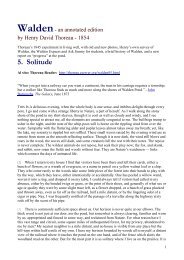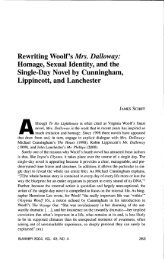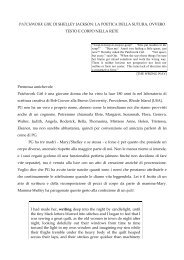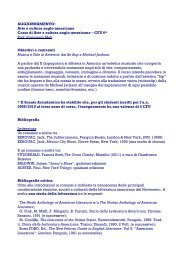London Kills Me - Paola Carbone
London Kills Me - Paola Carbone
London Kills Me - Paola Carbone
You also want an ePaper? Increase the reach of your titles
YUMPU automatically turns print PDFs into web optimized ePapers that Google loves.
October 20, 2003 The Nation. 25<br />
B O O K S & T H E A R T S<br />
<strong>London</strong> <strong>Kills</strong> <strong>Me</strong><br />
DIANA ABU-JABER<br />
BRICK LANE.<br />
By Monica Ali.<br />
Simon & Schuster. 369 pp. $25.<br />
Monica Ali was recently named one of<br />
Granta’s Best of Young British Novelists—an<br />
A-list of red-hot literary youth<br />
writing some of the most promising<br />
books on the contemporary scene. This<br />
was particularly interesting at the time because<br />
Ali’s first novel had not actually been<br />
published yet. She was selected on the<br />
strength of the manuscript for Brick Lane;<br />
it remained to be seen if her reviewers and<br />
readers would agree with the fanfare.<br />
Happily, Brick Lane fulfills that early<br />
promise and establishes Ali as a writer of<br />
real literary depth and dimension. There is<br />
an elegance and a steadfast, patient, careful<br />
construction of observed detail to this<br />
prose, a meticulous layering of character<br />
and social observation that endows Brick<br />
Lane with a sophistication and maturity<br />
that might surprise readers who’ve come to<br />
expect flash and dash in modern fiction.<br />
Ali mines much of the same territory as<br />
other young writers like Zadie Smith and<br />
Jhumpa Lahiri, whose work highlights cultural<br />
fusions, leaps between traditionalism<br />
and modernity. Their writing features sharpeyed<br />
immigrants and their children, who<br />
make their way through alien Western landscapes,<br />
assailed by the independence and<br />
isolation of individualism, and who respond<br />
by concocting their own amalgams of lives<br />
lived in between worlds. But there’s also<br />
a certain solemn dignity to Ali’s prose<br />
that distinguishes her from many other<br />
modern writers, a stateliness more reminiscent<br />
of Thomas Hardy’s gradual accumulation<br />
of detail than Smith’s flurries of<br />
wit and allusion.<br />
Brick Lane orbits around the experiences<br />
of Nazneen, a girl from the Muslim country<br />
of Bangladesh. At her birth, the ancient<br />
midwife pronounces her stillborn, and she<br />
Diana Abu-Jaber is the author, most recently, of<br />
Crescent: A Novel (Norton).<br />
Monica Ali has been compared to Zadie<br />
Smith and Jhumpa Lahiri, but her stately<br />
prose is more reminiscent of Thomas Hardy.<br />
is very nearly left for dead. Her sudden<br />
return to life marks her as a survivor. Her<br />
mother, who is “famous for crying,” instructs<br />
Nazneen that it is a woman’s role<br />
to accept her suffering with indifference:<br />
“What could not be changed must be borne.<br />
And since nothing could be changed, everything<br />
had to be borne. This principle ruled<br />
her life.” While Nazneen accepts this legacy<br />
of passive stoicism, however, she still has<br />
within her an inviolable sense of determination<br />
and resolve that will take years to<br />
come to full fruition.<br />
After her younger sister Hasina runs<br />
away with her lover, Nazneen’s angry father<br />
marries her to Chanu, a childish and pretentious<br />
older man. Chanu promptly brings<br />
Nazneen to England and treats her like an<br />
indentured servant. In England, away from<br />
her family and friends, Nazneen must face<br />
up to the immigrant’s long struggle to endure,<br />
to adapt, to re-create herself and to<br />
forge a new life. She becomes a great observer,<br />
taking in the daily comings and goings<br />
of her neighborhood. A tattooed lady<br />
sits in her window across the way, as passive<br />
as Nazneen, her strangeness manifest in<br />
her skin, in her unorthodox choices. In certain<br />
ways she is a physical totem for Nazneen’s<br />
own internalized mark of difference.<br />
Nazneen’s life is defined by her female<br />
Bangladeshi neighbors—her close friend,<br />
the jokey Razia, and the snooping Mrs.<br />
Islam. Their lives and their perceptions<br />
of the world are spun through deep channels<br />
of gossip and rumor. When Nazneen<br />
tries to resist the tyranny of this gossipmongering,<br />
Mrs. Islam corrects her sharply,<br />
pointing out that the gossip, intrusions<br />
and general “nosiness” of their cultural<br />
community provide a real sort of security<br />
and unity and actually are symptoms of<br />
social differences between the East and<br />
the West:
26 The Nation. October 20, 2003<br />
A HUNDRED LITTLE HITLERS: The Death<br />
of a Black Man, the Trial of a White<br />
Racist, and the Rise of the Neo-Nazi<br />
Movement in America.<br />
By Elinor Langer.<br />
<strong>Me</strong>tropolitan. 398 pp. $26.<br />
In 1990, The Nation ran a dispatch<br />
from Portland, Oregon, by editorial<br />
board member Elinor Langer titled<br />
“The American Neo-Nazi Movement<br />
Today.” The piece, which took<br />
up almost an entire issue of the magazine,<br />
was provoked by an event that had<br />
taken place two years earlier: Three<br />
skinheads in Portland had beaten an<br />
Ethiopian man to death with a baseball<br />
bat during a street brawl. Langer had<br />
originally planned to write about their<br />
trials for the magazine. But when the<br />
defendants pleaded guilty, she switched<br />
tack and embarked on an ambitious effort<br />
to examine a burgeoning faction<br />
bent on igniting a race war. She took<br />
an incident that rocked a community<br />
and turned her comprehensive report<br />
into a sociological study, one of the<br />
first of its kind on the subject.<br />
Thirteen years later, Langer has expanded<br />
on her research and published<br />
A Hundred Little Hitlers. Unlike her<br />
original article, which focused on the<br />
murder to draw out the history and<br />
sociology of the skinhead movement,<br />
Langer’s narrative here is centered on<br />
the civil trial that aimed to hold a California-based<br />
white power group—the<br />
White Aryan Resistance (WAR)—and<br />
its leader responsible for the death of<br />
the Portland man. The suit was brought<br />
by the controversial Southern Poverty<br />
Law Center, famously led by Morris<br />
Dees—a man whose effective fundraising<br />
tactics increased annual contributions<br />
to the SPLC from $2.5 million<br />
to $11.4 million between 1982 and<br />
1992. Tom <strong>Me</strong>tzger—WAR’s infamous<br />
leader—was the defendant, along with<br />
his son, WAR itself and two of the<br />
skinheads who had pleaded guilty to<br />
the killing (Dees excluded one skinhead<br />
from the lawsuit, hoping to win<br />
his cooperation). Although <strong>Me</strong>tzger<br />
is undeniably an ambitious racist—he<br />
IN OUR ORBIT<br />
The Believers<br />
ran a talk show, recorded regular racist<br />
bulletins on an answering machine<br />
known as the “Aryan Update,” worked<br />
with David Duke, ran for the Senate,<br />
participated in most of the major outgrowths<br />
and offshoots of the skinhead<br />
movement and was considered by many<br />
to be a leader of the next generation—<br />
Langer puzzles over why he was tried<br />
for the crime, and a considerable portion<br />
of the book is a complicated and not<br />
always critical portrait of the man.<br />
In her Nation piece, Langer predicted of<br />
<strong>Me</strong>tzger: “As long as he is alive and<br />
talking, he is likely to have a forum.<br />
He will not be easy to stop.” And she<br />
was right: Although <strong>Me</strong>tzger lost the<br />
trial and, with it, most of his assets, in<br />
the end a Faustian bargain was struck<br />
to settle the messy matter of <strong>Me</strong>tzger’s<br />
continuing to profit financially from<br />
racism. Langer reveals for the first time<br />
that, as part of <strong>Me</strong>tzger’s punishment,<br />
all money sent to him for racist propaganda<br />
is, to this day, divided in a twothirds,<br />
one-third split. (Unsurprisingly,<br />
neither <strong>Me</strong>tzger nor the SPLC has<br />
ever been eager to highlight this tidbit<br />
of information.) Ten of every thirty<br />
dollars donated to WAR goes to the<br />
SPLC, while twenty still finds its way<br />
into <strong>Me</strong>tzger’s coffers. Still, it’s not<br />
just this unseemly result that strikes<br />
Langer as a failure of the trial; she sees<br />
the SPLC’s victory as one of “historical<br />
emptiness.”<br />
In the book’s epilogue, Langer<br />
muses on the “ifs” of the episode, pausing<br />
to contemplate what could have<br />
come of the killing and its aftermath if<br />
the three skinheads who pleaded guilty<br />
to the murder “had gone to trial in the<br />
first place and the people of Portland<br />
had been forced to face the emergence of<br />
their youthful white supremacist movement<br />
with more candor and less panic.”<br />
Langer’s reasoned analysis prods readers<br />
to do just that, and in transcending<br />
the hype and showmanship that came<br />
to define her subjects, she reveals the<br />
shades of gray that permeate a cult that<br />
insists on seeing the world in black and<br />
white.<br />
EMILY BIUSO<br />
“The white people,” she said, “they all do<br />
what they want. It’s nobody’s business.<br />
“If a child is screaming because it is<br />
being beaten, they just close the door and<br />
the windows. They might make a complaint<br />
about noise. But the child is not<br />
their business, even if it is being beaten<br />
to death.<br />
“They do what they want. It is a private<br />
matter. Everything is a private matter.<br />
That is how the white people live.”<br />
Throughout this narrative runs a loud,<br />
angry reaction against the traditional woman’s<br />
imperative to endure passively whatever<br />
suffering is handed to her, to “wait”<br />
and “weep,” in the words of Nazneen’s female<br />
relatives. Contrasted with Nazneen’s<br />
immigrant struggles are the much sharper,<br />
more tangible hardships that her sister<br />
Hasina faces back in Dhaka. A physically<br />
beautiful girl who rejected the traditional<br />
type of marriage that Nazneen submitted<br />
to, Hasina seems determined to create her<br />
own fate.<br />
Hasina’s Western-style attempt at romantic<br />
freedom, however, runs up against<br />
the traditional strictures of Bangladeshi society.<br />
Her story comes in a series of heartbreaking<br />
letters, in which she reports her<br />
tragic turns of fate in an eternally stoic<br />
voice. And Ali’s unsentimental, frequently<br />
comedic tone manages to keep this section<br />
from descending into melodrama. Both<br />
sisters are equally confined by their circumstances,<br />
by the traditions that silence<br />
women and constrict them within an oppressive<br />
system of honor and shame.<br />
Certainly, in many ways this is a dark<br />
story, even a somber one, but the mood<br />
of the novel is redeemed by Nazneen’s<br />
ability to observe and to question events<br />
and people around her. She is under<br />
few illusions about the sort of man she<br />
married, gradually realizing that Chanu is<br />
essentially a self-absorbed pedant, a very<br />
sorry variety of loser in any language. In<br />
England, he suffers a classic sort of immigrant<br />
comedown, a shattering of great<br />
expectations, as he is incapable of the sort<br />
of stony-eyed pragmatism that his wife is<br />
trained in.<br />
But Nazneen is living a different sort of<br />
story than her mother and aunts did. When<br />
she herself gives birth to daughters, there<br />
is the sense that now things will be different.<br />
While one of her daughters is meek<br />
and pliable, her older daughter, Shahana,<br />
is impressively fierce and independentminded,<br />
full of her own will. She embodies<br />
the classic Westernized rebellious<br />
youth and she engages in a potent tug-of-
October 20, 2003 The Nation. 27<br />
war with her overbearing father. Chanu invents<br />
minute, torturous power games to<br />
assert his pre-eminence and subjugate his<br />
family—insisting that his daughters act as<br />
“page turners,” when he opens a book to<br />
read (they are required to intuit when the<br />
page must be turned). He lectures them<br />
pompously about the past grandeurs of<br />
Bangladesh, India and Muslims, but Shahana<br />
resists the dictates of the past, moving<br />
into her own as a daughter of both East<br />
and West.<br />
Despite the deep currents of tragedy<br />
and sadness in the novel, there are lovely,<br />
articulate bursts of description and surprising<br />
scenes of magical insight as Nazneen<br />
transforms and develops. There are no<br />
easy or automatic breakthroughs; rather,<br />
the novel follows the subtle intricacies of<br />
emotional free play, the internal currency<br />
of what it is to be a human in any part of<br />
the world. The moments of revelation are<br />
quiet, yet no less stirring for that, as in a<br />
brief, lighthearted scene in which Nazneen<br />
tries on a pair of pants for the first time<br />
or in a delicate, exquisite description of a<br />
baby’s charm:<br />
The baby was astonishing. He had little<br />
cloth ears, floppy as cats. The warmth of<br />
his round stomach could heat the world.<br />
His head smelled like a sacred flower.<br />
And his fists held mysterious, tiny balls<br />
of fluff from which he could not bear to<br />
be parted.<br />
Oddly enough, it is just when Nazneen<br />
embarks on her truest and deepest personal<br />
rebellion that a lull arises in the narrative.<br />
The story becomes more discursive, abstract<br />
and less intimate, as Nazneen becomes<br />
entangled with a new man and his<br />
Islamic organization, the Bengal Tigers,<br />
a group that is trying to define itself both<br />
religiously and culturally, struggling to respond<br />
to local anti-Muslim sentiment as<br />
well as to world events like the attacks of<br />
September 11.<br />
This is sensitive and important material,<br />
and Ali’s book makes some refreshing statements<br />
about the nature of racism, bigotry<br />
and contemporary religious chauvinism.<br />
But while the insertions of political and<br />
topical social critique are for the most part<br />
deftly handled, at times the narrative can<br />
seem agenda-heavy, larded with a few too<br />
many pronouncements and overly explicit<br />
speeches, information that feels only partially<br />
interwoven with the fabric of the<br />
story. A character’s statement, “And the<br />
government—it’s more scared of Islam<br />
than heroin,” strikes one as both thoughtprovoking<br />
and yet too heavy-handed for<br />
the fluidity of this story. Smaller, personal<br />
description gets diffuse; the characters’ages<br />
and the passage of time seem neglected and<br />
elusive. Big Issues are drawn into the story<br />
in a way that threatens to overshadow the<br />
delicate interplay of characters and their<br />
private realities.<br />
In the end, Nazneen’s story is brought to a<br />
dramatic crisis point, in which she must finally<br />
stop looking to her friends and family<br />
for direction and make her own way.<br />
And, while it’s a bit neat, the conclusion<br />
is also invigorating and affirming, a strong,<br />
final flourish that puts Nazneen in her<br />
proper place—as a woman making her way<br />
in the world, at the center of her own world.<br />
Of course, I can’t help asking myself:<br />
What is wrong with having a so-called<br />
agenda? Isn’t there something impressive<br />
and mind-opening when an artistic work is<br />
able to convey real information about the<br />
actual world? As with many fine writers,<br />
Ali’s writing is marked with the urgency of<br />
an author speaking in critical times, a novelist<br />
who has something that she absolutely<br />
must tell us, that we absolutely need to<br />
hear. Her story is deepened and intensified<br />
by this urgency; the characters are marked<br />
by it. In this respect, it is very much a novel<br />
for our times, a voice emerging directly
28 The Nation. October 20, 2003<br />
out of contemporary world experience.<br />
That is not to distract from the considerable<br />
imagination and creativity of Brick<br />
Lane, but only to say that the two—information<br />
and artistry—don’t have to be mutually<br />
exclusive or incompatible. You may<br />
notice that some of these characters are<br />
angry or agitated about things that are<br />
happening right now in the world around<br />
us. Ali isn’t being terribly self-conscious,<br />
ironic or deeply self-referential about this<br />
material, and I have the feeling that ultimately<br />
this is because these issues really<br />
matter to this writer.<br />
Brick Lane is a serious work in the best<br />
sense of the term. It has weight, purpose<br />
and passion. Exciting and timely, this<br />
novel gives us a slice of the world, contained<br />
within the sinuous contours of the<br />
particular, and in so doing, helps us find<br />
quietly private insights into noisy public<br />
affairs.<br />
■<br />
Justice Talking<br />
SCOTT L. MALCOMSON<br />
TAKING LIBERTIES: Four Decades in the Struggle for Rights.<br />
By Aryeh Neier. PublicAffairs. 406 pp. $30.<br />
In his memoir, Taking Liberties, Aryeh Neier emerges, almost despite himself,<br />
as a fascinating man. The story of his achievements is itself interesting and<br />
takes up the bulk of his pages. And I do mean the bulk. It is to the introduction<br />
that Neier relegates his childhood (born Berlin 1937) as a refugee in England<br />
(for a time he was confined to a hostel,<br />
“where, I am told, I stopped speaking”). We<br />
have a page on the Midlands towns where<br />
he grew up and what it was like to be a Jew<br />
there (odd at matins, otherwise not bad),<br />
then across the seas to Stuyvesant High<br />
in New York City, where he “opposed<br />
McCarthyism to the limited extent possible<br />
for a high-school student.” Neier devoured<br />
the works of the midcentury antifascist and<br />
(mostly) anti-Communist writers, Orwell-<br />
Camus-Koestler-Silone, and hurried on to<br />
Cornell. There he agitated for free speech<br />
and cottoned to Norman Thomas. Naturally<br />
he was drawn to the League for Industrial<br />
Democracy (LID). In what would<br />
become a pattern, he rocketed from newcomer<br />
to director (age 21).<br />
This new job accounts for his never attending<br />
law school. Neier is appealingly<br />
modest on this score: Considering the profound<br />
effects he would have on American<br />
and international law, he has bragging rights<br />
for having succeeded without a law degree,<br />
but he chooses not to exercise them. This<br />
lack of professionalist hauteur (or of insecurity)<br />
is remarkable in the field of human<br />
rights, which is full of people who are not<br />
really lawyers (though many have the degree)<br />
trying to convince themselves and<br />
Scott L. Malcomson is the author, most recently,<br />
of One Drop of Blood: The American Misadventure<br />
of Race (Farrar, Straus & Giroux),<br />
and is an adviser to the United Nations High<br />
Commissioner for Human Rights.<br />
others that they’re not really politicians.<br />
Neier very cleverly and exactly splits all<br />
these differences. He argues the law and he<br />
fights like a politician, as seen in his able<br />
demolition of Ernest Lefever as Reagan’s<br />
nominee to be assistant secretary of state<br />
for human rights.<br />
Neier’s opposition to Lefever and much<br />
else in the Reagan Administration was not<br />
ideological in any standard sense of the<br />
term. What he thinks of as human rights<br />
are really the basic civil and political rights<br />
of American law. Much of his advocacy,<br />
in the American context, consisted in expanding<br />
the reach of these rights into, for<br />
example, reproductive freedom, fair treatment<br />
in jails, free speech even when it is<br />
hateful and respect from the state even when<br />
you are mentally ill. Neier’s advocacy was<br />
not about elaborating the theory or expanding<br />
the number of rights. This remained<br />
true when he moved onto the international<br />
stage in the 1970s. What he took abroad was<br />
American rights, and to a considerable<br />
extent he, like many others, sees American<br />
power as the leading defender of those<br />
rights—if not always in reality, then in<br />
principle.<br />
His perspective seems to have been consistent<br />
since his student years on the centerleft.<br />
As director of the LID, Neier thought<br />
to invigorate its student branch, which he<br />
renamed Students for a Democratic Society<br />
in 1959. He writes that he hired, then fired,<br />
Tom Hayden: “It was too late. He had established<br />
his leadership of SDS.” At this








